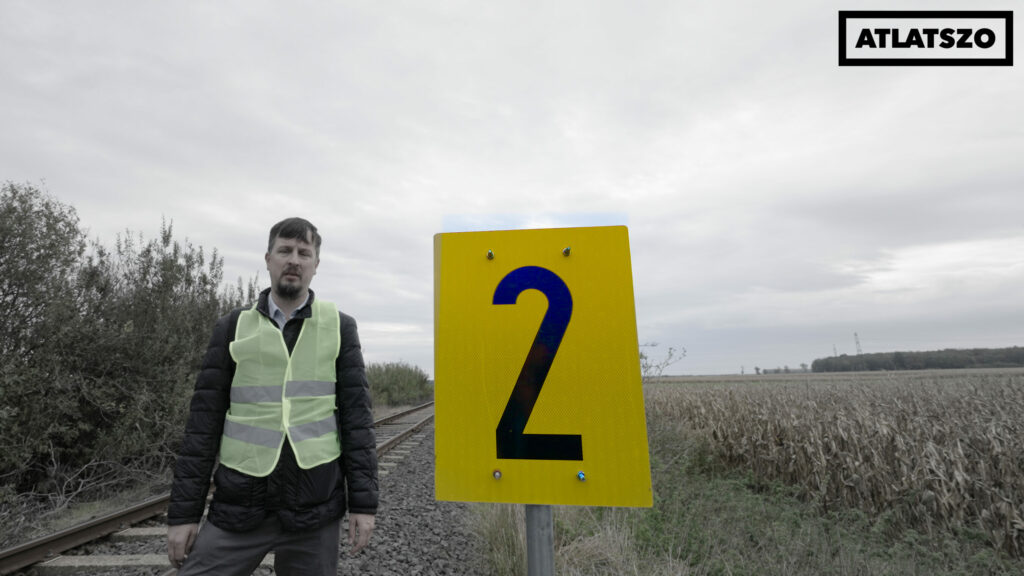The https://english.atlatszo.hu use cookies to track and profile customers such as action tags and pixel tracking on our website to assist our marketing. On our website we use technical, analytical, marketing and preference cookies. These are necessary for our site to work properly and to give us inforamation about how our site is used. See Cookies Policy
When it’s not the money that’s missing: are rural railways being deliberately smashed?
To the unfortunate masses who have been subjected time and again to the whims of the MÁV, it is shocking if a train runs on time. Fortunately, then, people aren’t too often shocked – the trains are now running slower on the newly renovated tracks than they did in the 1930s on 19th century infrastructure.
We embarked on our rail-side trek along the rocky Line 14 southward from Csorna, and then doddered down to Szany-Rábaszentandrás and back, to find the sources of sabotage. Something, we thought, must be afoot – especially after money has been shovelled into state-of-the-art stations and expert assessments showed no track deterioration even as passengers risk a herniated disk with every bumpy ride.

The spectacular retrogression did not occur without help. Fake slow signals, for one, contribute nicely.
“Fake slow signs are railway speed restrictions that MÁV imposes without any real justification and as a complete disregard of its own rules,”
explained civic organization Hungarian Transportation Club on their webpage.
It is not unusual for Hungarian infrastructure to undergo a striking collapse – what is unusual is that, in this case, a lack of funds is not the issue. It is a lack of competence, instead, that has doomed MÁV to utter chaos, and the inability to use pre-existing infrastructure for adequate public services.
The cost burden falls, as per usual, on the already impoverished rural areas of the country, which is in direct contrast to the government’s professed rural-first social policy.
The Gyurcsány Script
Line 14 was built in the late 19th century to transport goods produced on local estates. By the second half of the 20th century, the line primarily served students and commuters when Csorna became a key transfer for Győr, Sopron, Szombathely and Hegyeshalom.
In 2007, the Pápa-Csorna line became a casualty of the Gyurcsány government’s line closures. There were plans to dismantle the railway to make space for a bypass road around Csorna despite the line’s refurbishment less than a decade earlier and the impracticality of a bus replacement. Without parallel roads, buses would only have been able to cover the route with a costly 64-kilometer detour, while the entire railway line is just 37 km long.
Usage of the bus service underperformed in comparison to the railway, so bus service frequency was also cut to once or twice a day. The area, as a result, was almost entirely cut off from the rest of civilization – schools and jobs, opportunities in nearby cities.
Locals protested, which caught the attention of Fidesz, then of the opposition.
The party was incensed and they sharply criticized the left-wing government’s poor rail policy, accusing the administration of neglecting the countryside. Environmental organizations like Védegylet and the Clean Air Action Group concurred.
The 2007 closures, which affected 14 lines, were followed by closures of another 24 lines in 2009 under the Bajna administration, sparking yet another wave of protests. During the campaign, Fidesz promised to reopen the lines.
Since they’ve gained power in 2010, only ten lines have been reopened. Passenger rail services resumed only on one of the 14 lines that were closed in 2007. In 2012, during Pál Völner’s tenure as State Secretary, the number of trains per direction was cut from 10 to 2 per day, causing a 90 percent reduction in passengers. By the time service frequency was restored in 2022— following the high-quality renovation of the Szany-Rábaszentandrás station—the unreasonable speed restrictions had already been in place for three years, raising suspicions of sabotage.
Doing everything short of closure
Line 14 was reopened, but not much else has been done. It appears, in fact, that the aim is to scare passengers away, which would then allow the line to be closed once again.
From the 1930s to the 1980s, travel time was around one hour. After the 1980s reconstruction, this was reduced to 45 minutes. Renovations were completed by 1998. And yet, today, travel time has reached 75 minutes for the same distance.
The 23-minute stretch between Csorna and Szany-Rábaszentandrás has grown to a 45-minute journey, with average delays of around 10 minutes. Passengers often wait around an hour and a half because they miss their connection.
The issue isn’t poor track conditions. The track is well-maintained – better than the stretches from Nyugati to Vác or Cegléd. The track has crushed-stone ballast, 48kg rails, and close to 80 percent of it is supported by reinforced concrete sleepers. The single-unit Bz motor cars, which are the lightest vehicles in MÁV’s fleet, could travel at 60 km per hour on this line. Slowing down would only be necessary in a few spots. Currently, however, the Bzmot slows down to 20km per hour at several points.
Speed restrictions apply to around 80 percent of line 14. According to a forensic expert report and its annex obtained by the Hungarian Transport Club, 90 percent of these restrictions are either unjustified or excessively stringent. Board member Márton Feld showed us one slow-speed sign that does not actually exist in MÁV’s records.
It’s possible that MÁV has long forgotten its purpose – getting people from A to B – and is guided by poor practices in its daily operations. At the same time, experts who understand the importance of public transport are gradually leaving the field or finding opportunities abroad.
The state of transport and the closure of the rural lines are an antithesis to Fidesz’ pledge, voiced so eloquently by János Lázár: “Now it’s the countryside’s turn!”
And recently, rumours have been circulating that the Ministry of Construction and Transport plans to close more lines due to “the increasingly severe shortage of branch-line diesel railcars and the current situation on the railways” – hotly denied by the ministry.
On a list obtained by the IHO, nestled somewhere in there is the Pápa-Csorna line 14 – slated for closure.
Written by Lőrinc Tálos, translated by Vanda Mayer. Hungarian version of this story can be found here. Cover photo by Gergely Pápai

